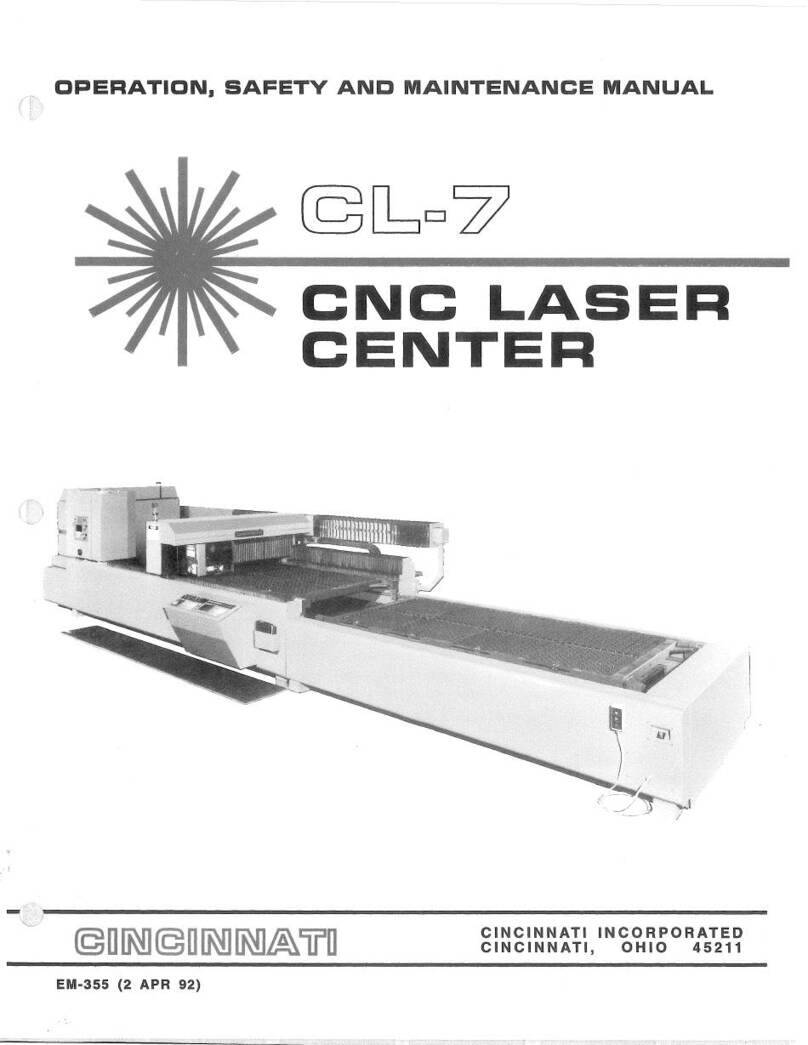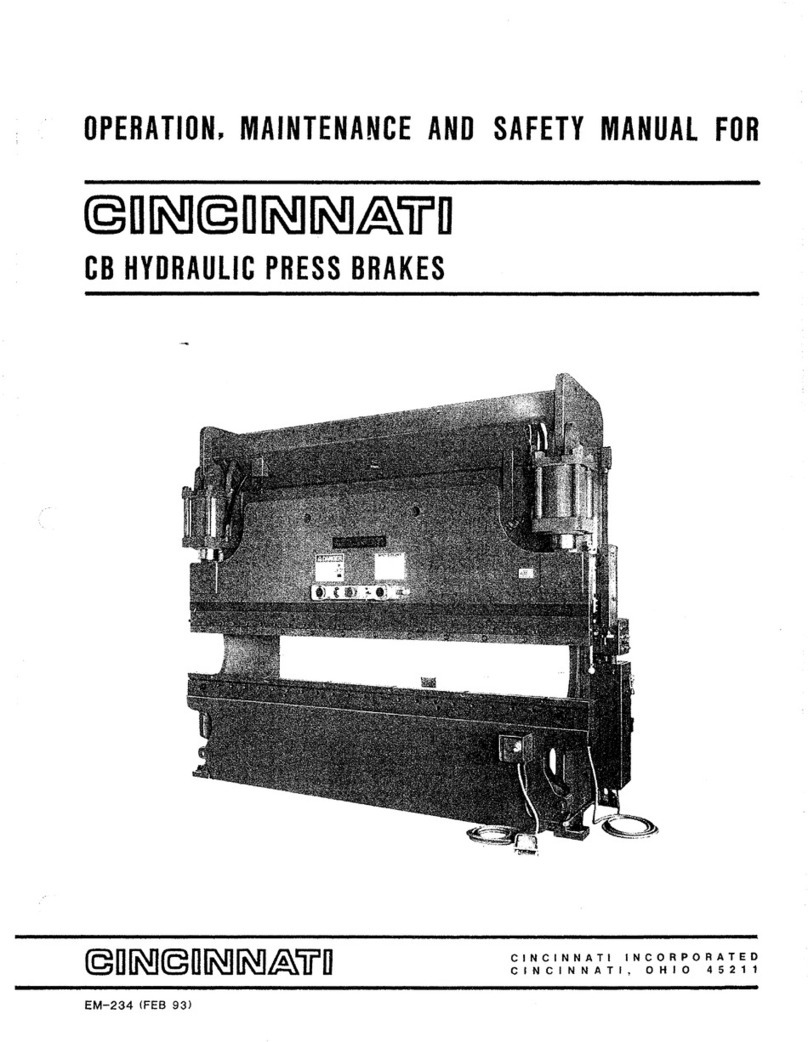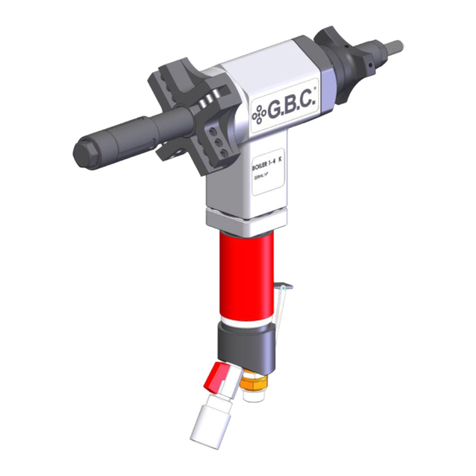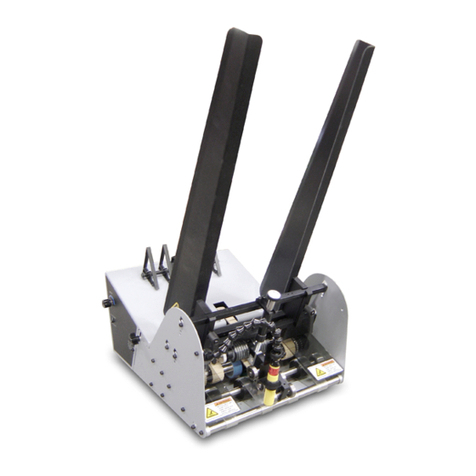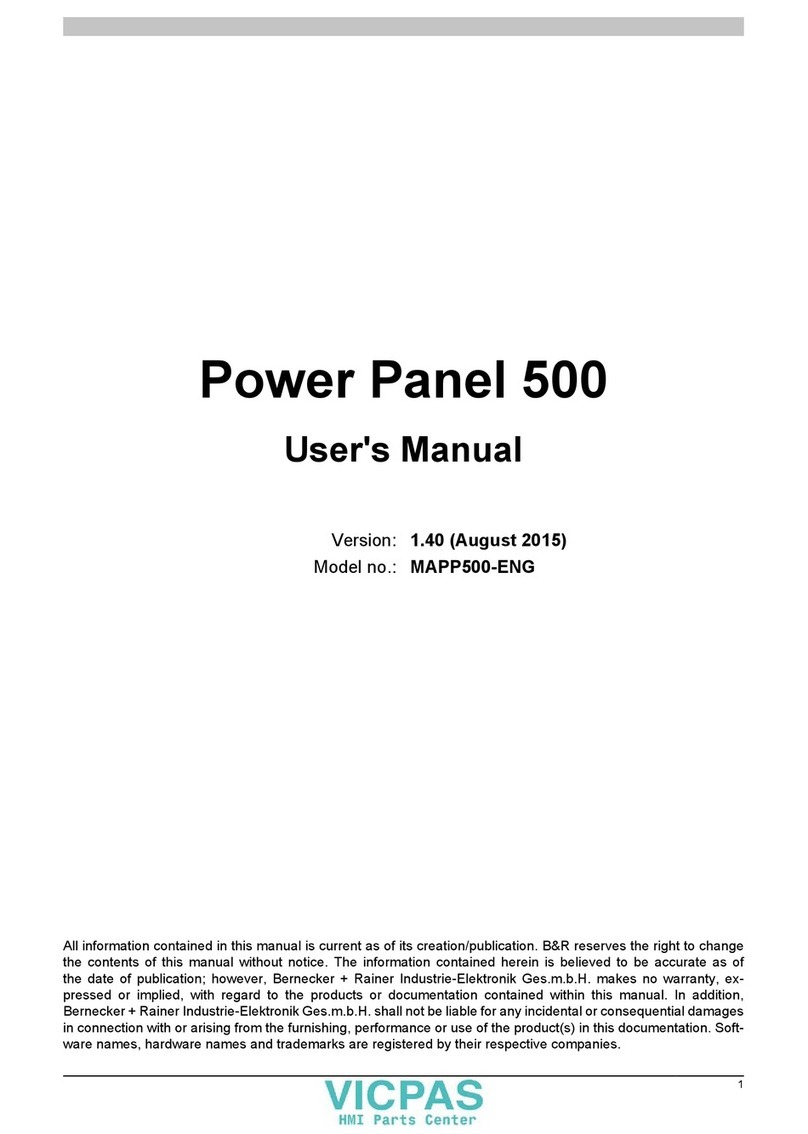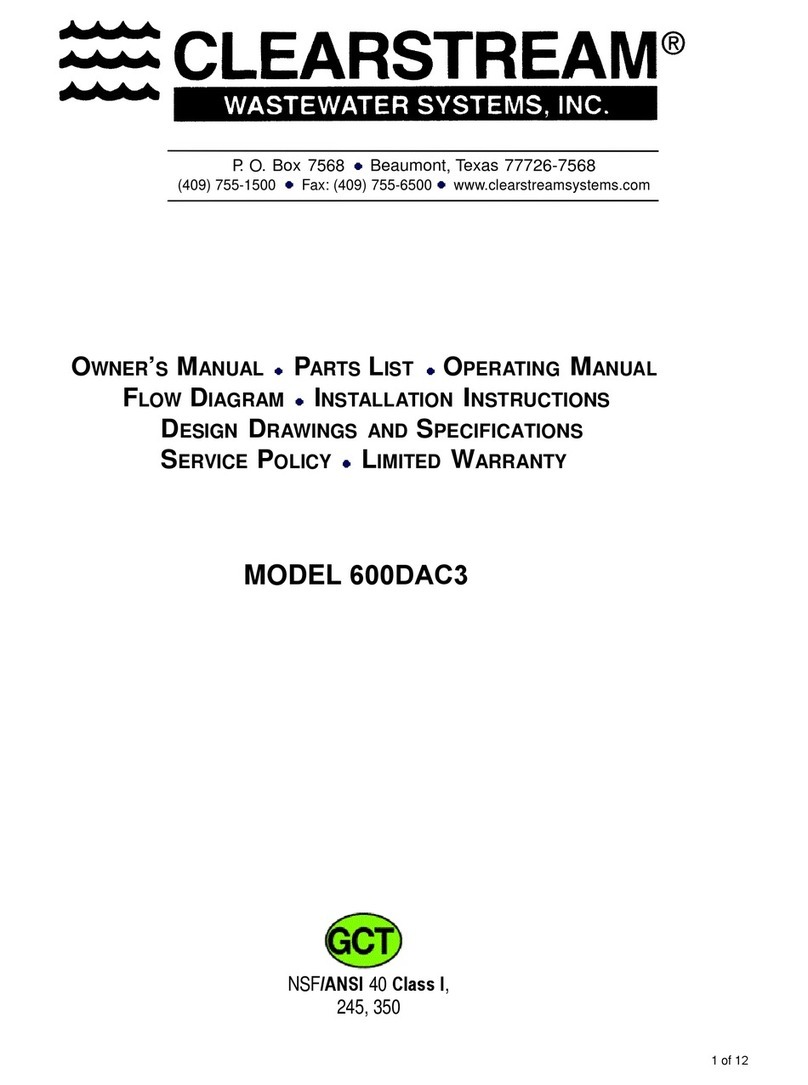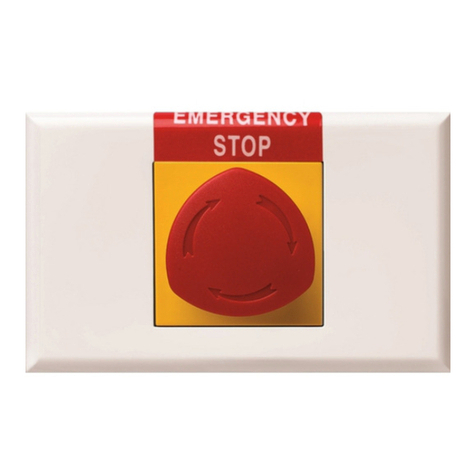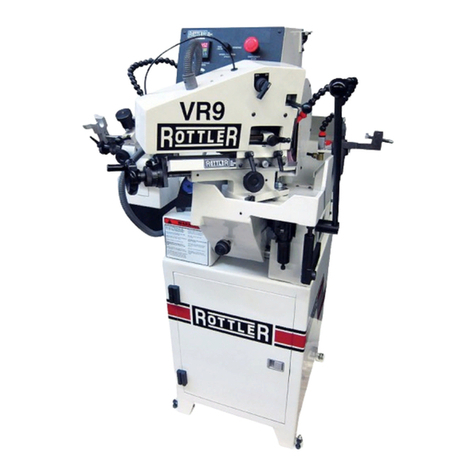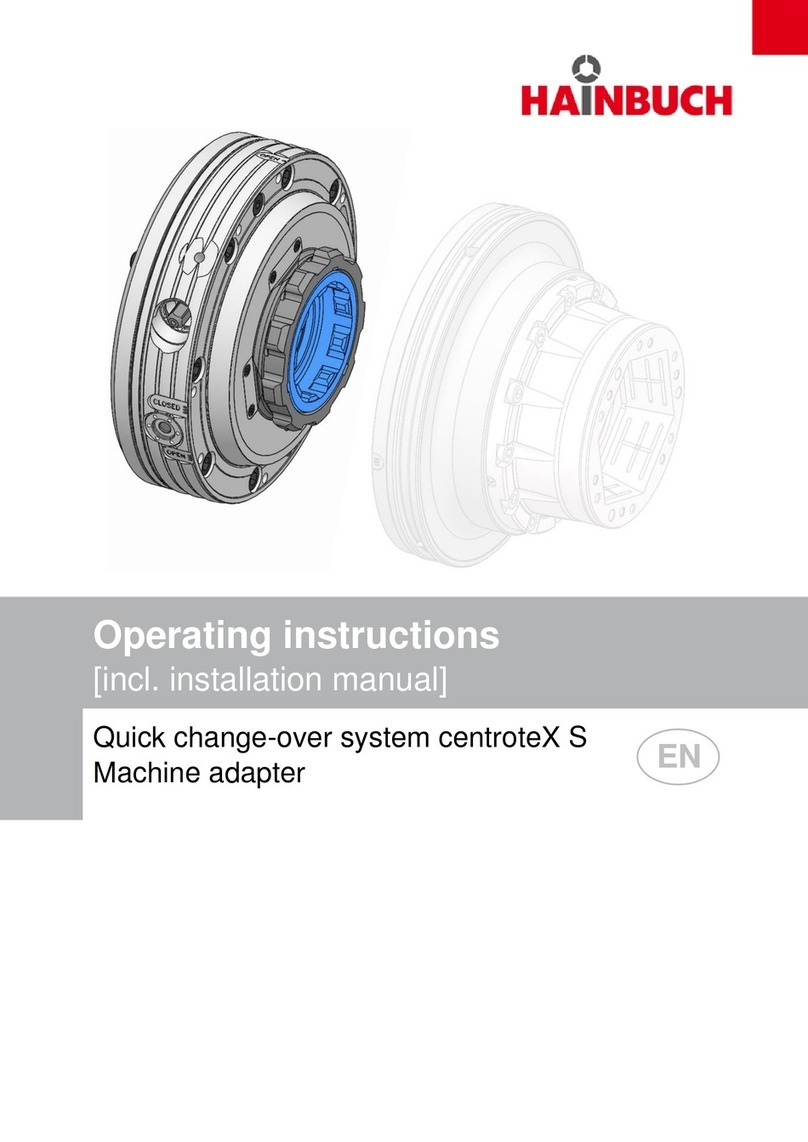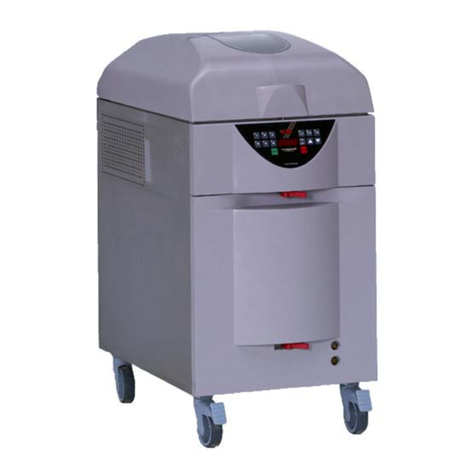Cincinnati CL-6 3000 Use and care manual

CL-6 3000
CNC LASER
CENTER
OPERATION, SAFETY AND MAINTENANCE MANUAL
CINCINNATI INCORPORATED
CINCINNATI, OHIO 45211
EM-439 (N-01/98) COPYRIGHT 1998
CINCINNATI INCORPORATED
PRELIMINARY
(01/98)

INTRODUCTION
SECTION 1 IDENTIFICATION
SECTION 2 INSTALLATION
LIFTING AND MOVING 2-1
FOUNDATION 2-2
ERECTION OF MACHINE 2-2
CHILLER 2-2
LEVELING 2-2
ELECTRICAL CONNECTION 2-4
SAFETY DEVICES 2-4
SECTION 3 SAFETY
SAFETY IS EVERYONE'S JOB 3-1
EXPLANATION OF LASER RADIATION 3-4
HAZARDS 3-4
ASSOCIATED HAZARDS 3-5
GAS STORAGE 3-6
PRECAUTIONS 3-9
SAFETY SIGNS 3-9
SAFETY GUIDELINES 3-11
SAFETY MAINTENANCE CHECK 3-12
SECTION 4 SPECIFICATIONS
DIMENSIONS 4-1
SPECIFICATIONS 4-1
PIPING CONNECTIONS 4-2
EXTERNAL OPTICAL ELEMENTS 4-2
GAS REQUIREMENTS 4-2
CAPACITIES 4-4
AMBIENT TEMPERATURE 4-5
PRINCIPAL OF OPERATION 4-5
CONTOURING ACCURACY 4-5
SECTION 5 SETUP AND USE
LOADING MATERIAL 5-1
GAGING 5-1
SECTION 6 MACHINE CONTROLS
OPERATOR CONTROL STATION 6-2
MACHINE OPERATOR PANEL 6-2
CRT / MDI PANEL 6-9
REMOTE STATION 6-9
U-AXIS REMOTE STATION 6-10
CL-6 3000 CNC LASER CENTER CONTENTS
EM-439 (N-01/98)

SECTION 7 OPERATION
MACHINE START-UP 7-1
CHILLER WARM-UP 7-1
CUTTING PROCEDURES 7-2
NORMAL SHUTDOWN 7-2
MANUAL ZERO RETURN SEQUENCE 7-2
BREAKAWAY CUTTING HEAD 7-3
ALIGNMENT SHOT 7-4
LENS CENTERING 7-5
LENS FOCAL POINT LOCATION 7-6
PROGRAMMABLE ASSIST GAS PRESSURE 7-7
RAPID PIERCE 7-8
PROGRAMMABLE PART COOLANT (Optional) 7-9
POWER CONTROL 7-9
ALIGNMENT LASER 7-10
PROGRAMMING 7-11
M-CODE LIST 7-11
SECTION 8 OPTIONS
OPTICS 8-1
CONTACT CUTTING HEAD 8-1
PROGRAMMABLE PART COOLANT 8-1
DRIP PAN FOR LOAD FRAME 8-1
FUME BLOWER 8-2
BALL TRANSFER LOAD STATION 8-2
INSTALLATION / START-UP KITS 8-2
MISCELLANEOUS 8-2
SECTION 9 MAINTENANCE AND ADJUSTMENTS
LUBRICATION REQUIREMENTS 9-1
AUTOMATIC LUBRICATION 9-1
MANUAL LUBRICATION 9-2
Z-AXIS LUBRICATION 9-2
U-AXIS LUBRICATION 9-2
MATERIAL CLAMP LUBRICATION 9-3
PALLET DRIVE MAINTENANCE 9-3
OPTICS HANDLING AND CLEANING 9-4
BEAM DELIVERY ALIGNMENT 9-6
PURPOSE 9-6
WHEN REQUIRED 9-7
TOOLS REQUIRED 9-7
COMPLETE SYSTEM ALIGNMENT 9-7
U-AXIS MIRROR ALIGNMENT (First Optic) 9-8
U-AXIS PHASE RETARDING MIRROR (Second Optic) 9-9
CORNER MIRROR (Third Optic) 9-9
X-AXIS BEAM ALIGNMENT (Fourth Optic) 9-10
Y-AXIS BEAM ALIGNMENT (Fifth & Sixth Optic) 9-11
Z-AXIS BEAM ALIGNMENT 9-13
FINAL ALIGNMENT CHECK 9-13
MIRROR COOLING 9-13
ALARM AND OPERATOR MESSAGES 9-14
PREVENTIVE MAINTENANCE 9-15
TROUBLESHOOTING 9-16
SECTION 10SERVICE AND PARTS
SERVICE 10-1
TECHNICAL TRAINING 10-1
ORDERING REPAIR PARTS 10-1
RETURNING PARTS FOR CREDIT 10-1
❦
COPYRIGHT 1998
CINCINNATI INCORPORATED

INTRODUCTION
CINCINNATI CL-6 3000 CNC LASER CENTER
The Laser Center produces two-dimensional contoured shapes from flat material by
moving a focused laser beam along a programmed path. The beam from a stationary
laser resonator is directed to a moving lens by two mirrors mounted on a moving
gantry. The workpiece remains stationary while a narrow strip of material is removed
along the path made by the lens. Material is removed by vaporization and melting
where the lens concentrates laser power into a small spot on the workpiece. Assist
gas and coolant are also used to control the cutting process.
The mirrors and lens are positioned by the gantry to produce the programmed work-
piece geometry. A CNC is used to command servo drives which control the gantry
motion. The CNC program is provided by the user and includes commands to specify
feedrate, laser power, assist gas and coolant. The Laser Center is equipped with an
exhaust system, which draws air down from the cutting area to assist in the removal
of process by-products.
PART QUALITY
The following factors affect part quality:
✦Machine condition
✦Operator ability
✦Set up and programming
✦Quality and type of material
CINCINNATI machines are designed to be rugged and durable. However, improper
adjustment or lack of maintenance can reduce the quality of parts produced on the
machine. The quality of a laser-cut edge depends on the combination of a uniform
laser beam of adequate power properly focused on the workpiece, an adequate supply
of the correct assist gas at the proper pressure and a servo system to move the laser
beam along the cutting path at a speed compatible with the material removal rate.
Uniform beam quality and power level are most influenced by the alignment and
cleanliness of the optical elements (internal resonator mirrors, external beam delivery
mirrors, pre-focusing lens and the focusing lens).
Critical manual adjustments are: Lens focal point location and lens-to-nozzle
centering.
Part quality depends on the CNC program to command the correct combination of
laser power, assist gas, feedrate and coolant for the material type and thickness being
processed. Part accuracy depends on the CNC program for proper use of kerf width
compensation and for selection of feedrate within radius contouring accuracy limits.
Material quality can affect the repeatability of process parameters. Material which has
uniform composition and thickness and a smooth, consistent and clean surface will
minimize variations in part quality.
PRELIMINARY
(01/98)

CL-6 3000 CNC LASER CENTER
1-1
EM-439 (N-01/98)
FIGURE 1 - 1 – Front View
1. CONSTANT BEAM STAND (U-Axis)
2. HIGH VOLTAGE WARNING
3. LASER WARNING LIGHT
4. GANTRY
5. CUTTING HEAD ASSEMBLY
6.
X-AXIS BEAM DELIVERY MIRROR BOX
7. UPPER WORK PALLET
13. MATERIAL CLAMPS
14. SCRAP / COOLANT COLLECTOR
15. OPERATOR'S MANUAL
16. SAFETY MAT
17. OPERATOR CONTROL STATION
18. MAIN FRAME
8. X-AXIS GUIDE & BALLSCREW
(Covered)
9. X-AXIS BEAM TUBE
10. SUPPORT GRID
11. LOWER WORK PALLET
12. LOAD FRAME
1 2 3 4 5 6 7 8
18
17
16 15 14 13 12
11
9
10
SECTION 1 IDENTIFICATION
PRELIMINARY
(01/98)

1-2
FIGURE 1 - 2 – Y-Plate and Non-Contact Head Assembly
1. ASSIST GAS PRESSURE SWITCH
2. ADJUSTMENT VALVE FOR COOLANT
3. Z-AXIS DRIVE MOTOR
4. COUNTERBALANCE SPRING LATCH
5. HINGED COVER
6. LENS COOLING WATER LINES
7. MAGNETIC BREAKAWAY COUPLING
8. ASSIST GAS CONNECTION
9. GAS JET TIP (Nozzle)
10. FOCUS ADJUSTING RING
11. 5.0” FOCAL LENGTH LENS HOLDER
12. 7.5” FOCAL LENGTH LENS HOLDER
13. CUTTING HEAD SAFETY RESTRAINT CABLES
14. PROGRAMMABLE ASSIST GAS CONTROLLER
12 3 4
5
6
7
8
14 13 12 11 10 9

❦
1-3
FIGURE 1 - 3 – Main frame, resonator end
1. X-AXIS BALLSCREW (Covered)
2. RAPID PIERCE SPARK SHIELD
3. PALLET SCRAPERS
4. PALLET SCRAP TRAYS
5. AUTO LUBE PUMP AND RESERVOIR
6. FUME DUCT
7. X-AXIS SERVO MOTOR
8. PALLET CHAIN DRIVE
9. PALLET DRIVE MOTORS (2)
9 8 7 6
5
4
3
2
1

Before proceeding, review the pre-installation
document that was left at the installation site
prior to machine delivery.
LIFTING & MOVING
Machine weights are provided in SECTION 4.
The main frame is lifted with four standard lifting
clevises. Two 1-1/4” diameter holes, located in front
of the U-axis stand, are for lifting the rear of the
machine. The load frame end of the machine is lifted
by two lifting links with spacers (C. I. Part #920584
and #921838). The two lifting links (supplied by
CINCINNATI INCORPORATED) are attached to the
inside of the main frame with 1”-8 UNC SHCS bolts.
See Figure 2-1.
When lifting with chains, cables or straps, use the
maximum length possible to reduce the side loading
generated at the lift points. Use spreader bars or
intermediate lifting beam if ceiling height will not
allow a high pick.
IMPORTANT: Extreme care must be taken not to
subject the machine to shock loads. The
machine must be lifted and set down gently.
The load frame is lifted by lifting straps and S-hooks
at each of the four outer machine corners. The S-
hooks are hooked in the access holes as shown. Ade-
quate padding must be used at all points to protect
the machine’s finish. See Figure 2-2.
The resonator is lifted using lifting straps and the
four eyebolts located on top of the resonator. Care
should be taken not to subject the resonator to
shock loads. See Figure 2-3.
FIGURE 2 - 1 – Lifting Main Frame
FIGURE 2 - 2 – Lifting Load Frame
! ! ! DANGER ! ! !
! ! ! DANGER ! ! !
WHEN LIFTING MAIN FRAME, BE SURE THAT LIFT-
ING LINKS (C. I. PART #920584) ARE INSTALLED
FOR LIFTING THE MACHINE. USING AN EYEBOLT
OR ANY OTHER LIFTING DEVICE NOT DESIGNED
FOR THIS SPECIFIC LIFT TASK COULD RESULT IN
SERIOUS INJURY OR DEATH TO BYSTANDERS
AND/OR CAUSE EXTENSIVE MACHINE DAMAGE.
2-1
EM-439 (N-01/98)
SECTION 2 INSTALLATION
PRELIMINARY
(01/98)
1.5” DIAMETER CLEVIS
THROUGH HOLE
1.5” THICK
LIFTING LINK

FIGURE 2 - 3 – Resonator lifting points
FOUNDATION
This section applies only to machines installed in an
area not affected by shock inducing equipment, such
as punch presses, turret punches, etc. Installations
involving this type of equipment in close proximity to
the machine require special considerations and
CINCINNATI INCORPORATED must be consulted.
A certified foundation plan drawing is provided when
the machine is ordered. This drawing will provide the
user with all the detailed information required to
locate the equipment and the eight machine
anchors. The eight anchor locations, each approxi-
mately 6” x 6” (152 x 152mm), should be prepared
by the customer prior to arrival of the equipment.
These eight pads must be pre-leveled to lie in the
same plane within .50” (12.7mm); and eight anchor
holes should be drilled as specified on Foundation
Plan drawing. Shims for final leveling, anchors,
studs, nuts and isolation pads are provided by
CINCINNATI INCORPORATED.
Floor should be reinforced concrete, have a mini-
mum thickness of 6” (152mm), and be free from
cracks and expansion joints. Reference your certified
Foundation Print for a complete foundation require-
ment description.
ERECTION OF MACHINE
After setting the machine on the anchor studs, place
washers and nuts on studs but do not tighten. Erec-
tion consists of the following steps:
1. Remove lifting clevises.
2. Remove all steel banding and protective wrap-
pings.
3. Install fume fan (if provided) and duct connecting
to fume plenum with flange and fasteners provid-
ed. Be sure to seal connection with a bead of
RTV silicone. Make the electrical connection to
the fan drive motor with wiring provided.
4. Install fume discharge duct and connect to cus-
tomer-furnished fume exhaust system.
5. Level the machine using the leveling procedure
below.
6. Install safety mat.
7. Install the operator’s control console with the
fasteners and rubber seal provided. Refer to
"ELECTRICAL CONNECTION" Section for addi-
tional information.
8. Install gas lines, wiring and hoses as described
in the pre-installation manual.
9. Refer to the laser manufacturer's manual provid-
ed for preparation of the laser resonator.
CHILLER
The water chiller is a free-standing unit requiring
only floor support. It is connected at a central loca-
tion with hoses furnished with machine (chiller loca-
tion shown on foundation plan) on the drive side at
the laser end of the frame. The chiller should be
positioned as shown on the foundation plan draw-
ing. Consult CINCINNATI INCORPORATED if an
alternative chiller location is required. The chiller
uses a 30% mixture of inhibited glycol and distilled
water as its cooling medium.
LEVELING
Leveling adjustments are made using jackscrews
which are accessible through openings in the main
frame above each of four mounting pads as shown in
Figure 2-4. Slotted shims are inserted between the
machine foot and steel spacer block as shown on the
foundation plan drawing. After shims are inserted,
jackscrews are to be backed-off or removed. The pro-
cedure for leveling is described below:
PRELIMINARY LEVELING
1. Cross-leveling is checked by placing a precision
level (.004”/ft. is sufficient for preliminary level-
ing) on machined pads on each end of main
frame. See Figures 2-4 and 2-5. Adjust with jack
screws and shim under mounting feet with
shims (provided). Note: Each scrap tray is held
in place by a single bolt on the resonator end.
2-2
LIFTING
EYEBOLTS

FIGURE 2 - 5 – Cross leveling (Preliminary)
2. Longitudinal level is checked on the top of the X-
Axis guide way. Adjust as described above.
FINAL LEVELING
Final leveling should be done with a CINCINNATI
INCORPORATED Service Representative present.
The purpose of final leveling is to ensure that the
gantry does not rotate about the X-axis as the gantry
moves from end-to-end. Excessive rotation will cause
laser beam misalignment during operation.
1. Use a 15” precision spirit level with a sensitivity
of .0005”/ft.
2. Place the level on the top of the gantry and posi-
tion the gantry at X = 0.
3. The top of the gantry is not machined. Therefore,
it will be necessary to shim one or both ends of
the level to establish a reference reading and
make the level sit solidly in place. Paper shims
can be used for this purpose.
4. Observe the position of the bubble while slowly
jogging the gantry from end-to-end. Maximum
deviation is one division of the level (.0005
in./ft.) from end-to-end. This deviation limit
ensures that the frame is not in a twist. Make
adjustments as described above, using
jackscrews to add or remove shims.
5. When Step 4 is complete, tighten anchor nuts
and recheck level as specified in Step 4.
2-3
FIGURE 2-4 – Reference points for machine leveling
SCRAP TRAYS
MOVED TO EXPOSE
LEVELING PAD
LEVELING PAD
(1 ON EACH END
OF FRAME)
Y-AXIS
LEVEL

ELECTRICAL CONNECTION
Each laser customer is supplied a complete set of
foundation plan drawings prior to machine ship-
ment. The electrical load requirements and connec-
tion points are called out on these drawings. Be cer-
tain that a suitably sized wire is brought to the main
disconnect and the proper voltage is supplied.
The CL-6 3000 standard electrical input is 460
volt, 3 phase and 50/60 Hertz. The machine must
be properly grounded in accordance with National
Electric Code NFPA 70, Sections 250-81, 83, 84
and 91. Place electrode as indicated on the foun-
dation drawing.
The machine controls have been designed to operate
satisfactorily with good quality incoming electrical
power. It is important that the electrical power be
free of excessive noise and power fluctuations. Refer
to the pre-installation instructions for details of
input power requirements.
SAFETY DEVICES
After chiller (and transformer) installation, wiring
and final leveling, the safety cable on the drive side
of the machine should be installed as shown on the
foundation plan drawing. Also verify that the safety
mats must be located and connected as shown in
the foundation plan drawing.
DO NOT START MACHINE UNTIL THOROUGHLY
READING THE SAFETY SECTION OF THIS MANU-
AL AND A CINCINNATI INCORPORATED SERVICE
REPRESENTATIVE IS PRESENT.
❦
2-4

SAFETY IS EVERYONE'S JOB
The CINCINNATI CNC Laser Center manufactured by
CINCINNATI INCORPORATED has been designed to
meet the highest order of reliability and ease of oper-
ator use. This system has been certified under Fed-
eral Regulations 21 CFR, subpart J, as a Class IV
Laser product as required by the Federal Radiation
Control for Health and Safety Act of 1968. This certi-
fication is on file with the Food and Drug Adminis-
tration Center for Devices and Radiological Health
Division, Office of Compliance, 2098 Gaither Road,
Rockville, Maryland 20850.
CINCINNATI INCORPORATED recommends the cus-
tomer read and understand the requirements of the
American National Standard for Safe Use of Lasers,
ANSI Z136.1 and American National Standard for
Machine Tools, ANSI B11.21-1997. Both are avail-
able from the American National Standards Insti-
tute, 11 West 42nd Street, New York, New York
10036.
For additional safety information we recommend:
✦Securing applicable safety data from the National
Safety Council, 1121 Spring Lake Drive, Itasca,
Illinois 60143-3201 and Laser Institute of Amer-
ica, 12424 Research Parkway, Suite 125, Orlan-
do, Florida 32826, (407) 380-1553.
✦Determining your responsibilities under your
state and local safety codes.
✦Requesting assistance from the loss prevention
department of your workmen's compensation
carrier.
Personnel responsible for your Laser Center operator
training program, maintenance, and manufacturing
operations must read and understand this safety
section and operator's manual. No one should setup,
operate or maintain this Laser Center until they
thoroughly understand it and know how to do their
job safely.
INTRODUCTION TO LASER SAFETY
The laser is an intense, highly directional beam of
light that, if directed, reflected or focused upon an
object, will be partially absorbed. This raises the tem-
perature of the surface and/or the interior of the
object, which can potentially cause an alteration or
deformation of the material. These properties, which
have been applied to laser material processing, can
also cause adverse biological effects in human tissue.
The CINCINNATI CNC Laser Center operates in the
far-infrared region, which is invisible and has high
heat energy. The beam emitted has a wavelength of
10.6 µm (micrometers).
A BRIEF DISCUSSION ON RADIATION
Radiation is defined in Webster's as "energy radiated
in the form of waves or particles". Radiation is a
form of energy emitted from a wide range of sources,
some man-made and some natural. The electromag-
netic spectrum covers those forms of energy with
wavelengths of approximately 10-11 meters to 107
meters. That corresponds to frequencies of approxi-
mately 1022 hertz to approximately 1000 hertz.
All forms of electromagnetic radiation travel at the
speed of light, but at differing frequencies. The wave-
length of such a wave is inversely proportional to the
frequency and often a particular type of radiation is
described in terms of its wavelength rather than its
frequency.
The energy transmitted by such radiation is also
related to its frequency - the higher the frequency,
the greater the energy. The energy of radiation tends
to interfere with the internal energy that holds atoms
together as molecules. If the energy of a ray of radia-
tion is great enough, it will attract electrons away
from an atom or add additional electrons to it.
Radiation that lacks the energy to deform atoms,
(non-ionizing) radiation, can still cause bodily harm
by raising the temperature of the body tissue the
radiation contacts. If this tissue is the hardened,
dead-cell tissue of the outer skin, it does little harm.
It may produce reddening of the tissue and mild
soreness. However, if that same radiation energy
gets inside the body to less well-protected tissue, the
tissue may not only be heated, but may become
damaged as well. The eyes are also very susceptible
to radiation energy. The cells of the cornea and reti-
na are easily destroyed and must always be protect-
ed from radiated energy. Ordinary industrial type
safety glasses will provide this protection.
Figure 3-1 is a chart of that portion of the electro-
magnetic spectrum pertinent to our discussion. The
area the CINCINNATI CL-6 3000 LASER operates in
is located between 3x10-5 and 3x10-6 meter wave-
length. This brief introduction has been prepared to
alleviate any unwarranted worries regarding laser
radiation safety.
3-1
EM-439 (N-01/98)
SECTION 3 SAFETY
PRELIMINARY
(01/98)

3-2
1022
1021
1020
1019
1018
1017
1016
1015
1014
1013
1012
1011
1010
109
108
107
106
105
104
103
100
10
3x10-14
3x10-13
3x10-12
3x10-11
3x10-10
3x10-9
3x10-8
3x10-7
3x10-6
3x10-5
3x10-4
3x10-3
3x10-2
3x10-1
3
30
3x102
3x106
3x103
3x104
3x105
3x107
Microwave
Radio -frequency
(RF) waves
Infrared
rays
Lasers
Ultraviolet
rays
Gamma
rays
X-rays
CINCINNATI
CNC LASER
Visible light (380-780
nanometers wavelength)
FM broadcast band
AM broadcast band
(535-1605 kilohertz)
Telephone
Commercial electric
power (60 hertz)
FREQUENCY
(hertz) WAVELENGTH
(meters)
FIGURE 3 - 1 – Electromagnetic spectrum

SAFETY STANDARDS
Research studies, along with an understanding of
the hazards of sunlight and conventional, man-made
light sources have also permitted scientists to estab-
lish safe exposure limits for nearly all types of laser
radiation. These limits are generally referred to as
Maximum Permissible Exposures (MPE's) by laser
safety specialists. In many cases, it is unnecessary
to make use of MPE's directly. The past experience
gained in millions of hours of laser use in the labora-
tory and in industry has permitted the development
of a system of laser hazard categories. Each laser is
placed into one of at least four separate classes, or
risk categories. The safety measures to reduce or
eliminate accidents depend upon which class of
laser is being used.
There are a variety of laser safety standards.
These include regulations of the Federal Govern-
ment, and of several state and local governments.
Additionally there are non-regulatory standards,
such as the ones of the American National Stan-
dards Institute (ANSI) and of the American Con-
ference of Governmental Industrial Hygienists
(ACGIH). On the international scene, the World
Health Organization (WHO) has laser safety
guidelines, and the International Electrotechnical
Commission (IEC) has been developing laser safe-
ty standards. Of the standards that apply to
users, the ANSI standard Z136.1 is probably the
most important and most often quoted. It pro-
vides information on how to classify lasers for
safety, laser safety calculations and measure-
ments and laser hazard control measures. A more
recent ANSI Standard B11.21-1997 pertains to
safety requirements for laser used in machine
tool applications. Also, in their “Techanical Man-
ual” (Directive TED 1.15), OSHA provides a good
discussion of “LASER HAZARDS” and their
approach to laser equipment. Ask for OSHA
Instruction PUB8-1.7 entitled “Guidelines for
Laser Safety and Hazard Assessment”.
LASER HAZARD CLASSIFICATION
As previously indicated, laser systems can be
grouped into at least four primary categories to indi-
cate relative potential risk:
Class I - A Class I laser is considered safe based
upon current medical knowledge. This class
includes all lasers or laser systems which cannot
emit levels of optical radiation above the exposure
limits for the eye under any exposure conditions
inherent in the design of the laser product. There
may be a more hazardous laser embedded in the
enclosure of the Class I product, but no harmful
laser radiation can escape the enclosure.
Class II - A Class II laser or laser system must emit a
visible laser beam, which by its very bright nature
will be too dazzling to stare into. Momentary view-
ing is not considered hazardous since the upper
radiant power limit on this type of device is 1 mW
which corresponds to the total beam power enter-
ing the eye for a momentary exposure of 0.25 sec-
ond that is just safe (i.e., the MPE for a 0.25 sec-
ond exposure).
Class III - A Class III laser or laser system can emit
any wavelength, but it cannot produce a haz-
ardous diffuse reflection unless focused or viewed
for extended periods at close range. It is also not
considered a fire hazard or a serious skin hazard.
Any CW (continuous wave) laser that is not Class
I or Class II is a Class III device if its output power
is 0.5 W or less. Since the output beam of such a
laser is definitely hazardous for intrabeam view-
ing, control measures center on eliminating this
possibility.
Class IV - A Class IV laser or laser system is any
that exceeds the output limits (Accessible Emis-
sion Limits, AEL's) of a Class III device. As would
be expected, these lasers may be either a fire and
skin hazard or a diffuse reflection hazard. Very
stringent control measures are required for a
Class IV laser or laser system.
CONTROL MEASURES
The CINCINNATI CNC Laser Center has been
designed and manufactured using the highest
engineering control measures practical, however,
even these high standards have limitations. Laser
safety requirements call for administrative and
procedural controls to be incorporated in the use
of lasers in order to minimize or eliminate the
potential of personal injury during laser operation.
The position of Laser Safety Officer (LSO) must be
established within the management organization of
a company using a laser cutting machine. This
person has the responsibility and authority to
monitor and enforce the control of laser hazards.
He or she should have the knowledge to effectively
evaluate and control hazards involved in laser cut-
ting. The LSO is responsible for requiring written
standard operating, maintenance and service pro-
cedures for the laser center. These procedures
should be kept at the laser center for reference by
operating, maintenance and service personnel.
Continued education and training for operating,
maintenance and service personnel is mandatory
for an adequate laser safety program to exist. The
Laser Safety Officer should see to it that person-
3-3

nel involved in various aspects of laser operation
have been trained to a level commensurate with
the level of potential hazards to which they may
be exposed.
OPERATING PERSONNEL
These people are responsible for the productive
use of the laser cutting center over the full range
of its intended function. These persons should be
thoroughly familiar with all operating controls,
adjustments and hazards associated with their
function.
MAINTENANCE PERSONNEL
These individuals are responsible for and should
be thoroughly trained in the performance of
adjustments or procedures specified in the User
Information manuals provided by the CINCINNATI
INCORPORATED. Functions performed are to
ensure the intended performance of the laser cen-
ter is realized.
SERVICE PERSONNEL
These individuals are responsible for the perfor-
mance of procedures and adjustments described in
the manufacturer's service manual. The duties of a
service person requires a higher level of training
and education than that of the maintenance func-
tion. However, a service individual does not neces-
sarily include the duties or responsibilities of a
maintenance person.
SAFETY DIRECTOR
A strong commitment from management must exist in
order for an effective safety program to be established
with personnel involved in the use of the CINCINNATI
CNC Laser Center. Additional information concerning
this topic can be located in the American National
Standard Z136.1-1993. Refer to Appendix D of this
standard for a guide to organizing and implementing a
laser safety and training program.
EXPLANATION OF LASER RADIATION
Light is a form of energy that is released from indi-
vidual atoms or molecules in a substance. To under-
stand how a laser works, it is necessary to know
something about the nature of atoms and how they
interact with light and other forms of energy.
Every atom is a storehouse of energy. The amount of
energy in an atom depends in part on the motion of
the electrons that orbit the atom's nucleus. When an
atom absorbs energy, the energy levels of the elec-
trons increase and the atom is said to be excited.
The atoms of a substance become excited when they
absorb heat, light, or other forms of energy that pass
through the substance. An excited atom can return
to its normal energy level by releasing its excess
energy in the form of light. This release of light is
called spontaneous emission.
In spontaneous emission, excited atoms release light
irregularly. As a result, the light has different fre-
quencies, different phases and travels in different
directions. Light released in this way is called inco-
herent light. Such light is produced by the sun and
by ordinary electric light bulbs.
Excited atoms also may release light systematically.
This kind of release, called stimulated emission, is
the main process that takes place in a laser. Stimu-
lated emission occurs when the energy released from
one atom interacts with another atom that is still
excited. The interaction stimulates the excited atom
into releasing its own energy as light. Most of the
light produced by stimulated emission has the same
frequency and same phase as the stimulating light.
It also travels in the same direction, and so it com-
bines with and amplifies the triggering light. Such
light is called coherent radiation.
LASER TYPES
There are three major kinds of lasers based on
their lasing medium: solid lasers, gas lasers and
liquid lasers.
The CINCINNATI CNC Laser Center model CL-6
3000 is a gas type laser. Gas lasers use a gas or a
mixture of gases as their light-amplifying sub-
stance. In most cases, the gas is contained in a
glass or quartz tube from one to three feet (30 to 91
centimeters) long. Such gas lasers have been built
in glass tubes measuring up to 30 feet (9 meters) in
length. Gas lasers have several power sources,
including chemical reactions, electric current, elec-
tron beams and ultraviolet rays. Most gas lasers,
produce a continuous beam of light. They can also
produce beams of higher average power than solid
lasers. They can do so because they are cooled by
the gas as it flows through the tube. Light from a
gas laser has a narrower frequency range than the
light from a solid laser.
A second laser is part of the CL-6 3000 CNC Laser
Center. This is a diode laser which produces a visi-
ble red beam. Due to the visible nature of this
beam and its power level, it is designated as a
Class IIIA laser product. Class IIIA levels of laser
radiation are considered a chronic viewing hazard
and thus the warning not to stare into the red
beam as given on our warning sign.
3-4

HAZARDS
EYE HAZARDS
The eye hazards represent a potential for injury to
several different parts of the eye, generally depending
upon which eye part absorbs the most radiant energy.
Laser radiation in the far-infrared region with wave
lengths of 3µm to 1 millimeter will be absorbed in
the front surface of the eye. Thus, if the eye is not
protected, it may receive damage to the cornea and
lens from direct or reflected laser beam exposure.
Therefore, eye protection must be worn by all opera-
tion, maintenance and service personnel while work-
ing at the CINCINNATI CNC Laser Center. The type
and style of eye protection to use should be worked
out with the supplier of your shop eye protection
program. In general, the normal safety glasses with
side shields used in metal working shops will pro-
vide all the protection necessary. It is the user's
responsibility to establish and enforce an eye protec-
tion program.
SKIN HAZARDS
Laser radiation striking the skin is reflected,
absorbed, and transmitted; the percentage of each
depends upon the characteristics of the skin at the
wavelengths of concern. Effects on the skin from
absorbed radiation may vary from mild redness to
blistering and/or charring, depending upon the total
energy absorbed and the rate at which it is
absorbed. Unnecessary exposure of the skin to laser
radiation should be avoided regardless of the level of
radiant energy.
The CINCINNATI CNC Laser Center has been tested
and found to have no detectable x-ray emissions and
related hazards. In general, the hazards presented
by the CINCINNATI CNC Laser Center, which oper-
ates in the far-infrared (invisible light) region, will be
severe burns, lacerations and possible amputation if
members of the body come in contact with the direct
beam or close to reflected beams of high energy. The
design of the Laser Center provides engineered pro-
tection from these hazards for personnel while prop-
erly using this equipment. This basic design should
not be altered or modified in any manner.
ASSOCIATED HAZARDS
ELECTRICAL
Because of the high electrical energies used to gener-
ate the laser beam in the CINCINNATI CNC Laser
Center, electrocution hazards are possibly a far
greater danger to personnel than those of the laser
beam itself. This is why no access to high electrical
energy is possible without going through a safety
interlocked door or panel. Before any maintenance
or service is undertaken, you should ensure that the
laser component has been isolated from the electri-
cal service and all other precautions taken as pre-
scribed in this manual and the other component
manuals provided.
FIRE
Fire hazard is present in the processing area
through interaction with the laser beam and materi-
als present in the work area. Debris and fine partic-
ulate generated from laser cutting some materials,
i.e. plastics, aluminum, fabrics, etc., can present a
fire hazard if allowed to accumulate. Good house-
keeping practice should be followed so area below
cutting zone is inspected daily and cleaned on an as
needed basis or every 1000 hours of operation. The
fume collection plenum (air collection duct) below
the cutting zone should also be checked for debris
accumulation. Removable covers are provided for
this inspection and cleaning procedure.
Additional fire hazards exist in the electrical controls
enclosed in the Laser Center cabinets. Appropriate
fire equipment should be available and the purpose
of such equipment should be understood by operat-
ing personnel. This equipment should be provided to
extinguish or control small fires only. Follow basic
fire fighting procedures.
! ! ! DANGER ! ! !
! ! ! DANGER ! ! !
SET THE “DRIVES” KEYSWITCH ON OPERA-
TOR CONTROL CONSOLE TO “LOCK/OFF”
POSITON AND REMOVE THE KEY TO PREVENT
MOVEMENT OF GANTRY OR PALLETS DURING
THIS PROCEDURE.
! ! ! DANGER ! ! !
! ! ! DANGER ! ! !
HIGH VOLTAGE OF UP TO 10,000 VOLTS IS PRE-
SENT IN THE LASER RESONATOR AND POWER
SUPPLY CABINET. CONTACT WITH VOLTAGE
CARRYING CONDUCTORS IS NOT NECESSARY,
AS ENERGY AT THIS POTENTIAL CAN JUMP TO
A CLOSE BODY AT GROUND POTENTIAL – SUCH
AS YOURSELF, CAUSING IMMEDIATE DEATH. DO
NOT ENTER ANY HIGH VOLTAGE AREA WITH-
OUT FIRST DISCONNECTING POWER. REFER TO
LASER MANUFACTURER'S SERVICE MANUAL
BEFORE ENTERING THIS CABINET.
3-5

FUME AND DUST
The CINCINNATI CNC Laser Center requires ade-
quate ventilation or respirators. The ventilation
requirements should be determined by a profes-
sional qualified to assess ventilation control
requirements.
The CL-6 3000 Laser Center has provisions for an
exhaust system that draws air down from the cut-
ting surface. The optimal exhaust rate for your spe-
cific application of the CL-6 3000 Laser Center
should be determined by a professional qualified to
assess ventilation systems.
The OSHA-required Material Safety Data Sheet for
the material being processed should be reviewed to
aid in determining the nature and composition of
the fumes being released. The need and subse-
quent design of a device to eliminate poisonous
emissions from the ventilation exhaust should be
made by a qualified professional. Finally, personal
exposure to fumes should be determined by a pro-
fessional qualified to evaluate workplace exposures
to chemical and physical hazards.
As mentioned above, debris and fine particulate are
generated by the process. This material should not
be allowed to accumulate in the duct leading to the
final exit point or control device. Combustible
materials, i.e. plastics, fabrics, aluminum, etc.,
could present a larger hazard than mild or stain-
less steel materials. A qualified professional should
evaluate this hazard.
Operation of the CL-6 3000 Laser Center and venti-
lation system/control device may be subject to
local, state and federal environmental and occupa-
tional protection laws and regulations. A profes-
sional qualified to assess environmental and occu-
pational protection laws and regulations must be
consulted before the CL-6 3000 Laser Center is
installed and operated.
GAS STORAGE
Various gases are used in the laser cutting process
to assist in the actual cutting or to perform auxiliary
functions. The gases most commonly used are oxy-
gen, nitrogen, carbon dioxide, helium and com-
pressed air. These gases are commonly available in
compressed gas cylinders. Oxygen, nitrogen and
helium are also available as cryogenic liquid. Carbon
dioxide, while not classified as a cryogenic, is also
widely available in liquid form. The discussion below
will address safety consideration when storing and
handling compressed gas cylinders. Later in this
section will be a discussion on safety precautions
concerning cryogenic liquids.
COMPRESSED GAS CYLINDERS
HANDLING
Serious accidents may result from the misuse,
abuse, or mishandling of compressed gas cylinders.
Workers assigned to handling pressurized cylinders
should be properly trained and should work only
under competent supervision. Observing a few basic
rules will help control hazards in the handling of
compressed gas cylinders.
✦Because of their shape, smooth surface, and
weight, cylinders are difficult to carry by hand.
Cylinders may be rolled on their bottom edge but
never dragged. Cylinders weighing more than 40
pounds (18.2 kg) total shall be transported on a
hand or motorized truck, suitably secured to
keep them from falling.
✦Do not lift compressed gas cylinders with an elec-
tromagnet. Where cylinders must be handled by a
crane or derrick, carry them in a cradle or suit-
able platform and take extreme care that they are
not dropped or bumped. Do not use slings.
✦Do not drop cylinders or let them strike each
other violently.
✦Do not use cylinders for rollers, supports, or any
purpose other than to contain gas.
✦Do not tamper with safety devices in valves or on
cylinders.
✦When empty, cylinders are to be returned to the
vendor. Mark them EMPTY or MT with chalk.
Close the valves and replace the valve protection
caps, if the cylinder is designed to accept a cap.
✦Always consider cylinders as being full and han-
dle them with corresponding care. Accidents
have resulted when containers under partial
pressure were thought to be empty.
STORING
Cylinders should be stored in an upright position in
a safe, dry, well-ventilated place prepared and
reserved for the purpose. Flammable substances,
such as oil and volatile liquids, should not be stored
in the same area. Cylinders should not be stored
near elevators, gangways, stairwells, or other places
where they can be knocked down or damaged.
! ! ! DANGER ! ! !
! ! ! DANGER ! ! !
POISONOUS FUMES MAY BE FORMED BY LASER
CUTTING. DO NOT BREATHE FUMES.
3-6

✦Oxygen cylinders should not be stored within 20
ft. (6 m) of cylinders containing flammable gases
or near the location of other highly combustible
materials.
✦Cylinders are not designed for temperatures in
excess of 130°F (54°C). Accordingly, they should
not be stored near sources of heat, such as radi-
ators or furnaces, or near highly flammable sub-
stances like gasoline.
✦Cylinder storage should be planned so that cylin-
ders will be used in the order in which they are
received from the supplier. Empty and full cylin-
ders should be stored separately, with empty
cylinders being plainly identified as such to avoid
confusion. Group together empty cylinders which
have held the same contents.
USING
Safe procedures for the use of compressed gas cylin-
ders include:
✦Use cylinders in an upright position and secure
them against accidentally being knocked over.
✦Unless the cylinder valve is protected by a recess
in the head, keep the metal cap in place to pro-
tect the valve when the cylinder is not connected
for use. A blow on an unprotected valve might
cause gas under high pressure to escape.
✦Make sure the threads on a regulator or union
correspond to those on the cylinder valve outlet.
Do not force connections that do not fit.
✦Open cylinder valves slowly. A cylinder not pro-
vided with a handwheel valve should be opened
with a spindle key or a special wrench or other
tool provided or approved by the gas supplier.
✦Do not use a cylinder of compressed gas without
a pressure reducing regulator attached to the
cylinder valve, except where cylinders are
attached to a manifold, in which case the regula-
tor will be attached to the manifold header.
✦Before making connection to a cylinder valve out-
let, "crack" the valve for an instant to clear the
opening of particles of dust or dirt. Always point
the valve and opening away from the body and
not toward anyone else.
✦Use regulators and pressure gages only with
gases for which they are designed and intended.
Do not attempt to repair or alter cylinders,
valves, or attachments. This work should be
done only by the manufacturer.
✦Unless the cylinder valve has first been closed
tightly, do not attempt to stop a leak between
cylinder and regulator by tightening union nut.
✦Do not permit sparks, molten metal, electric cur-
rents, excessive heat, or flames to come in con-
tact with the cylinder or attachments.
✦Never use oil or grease as a lubricant on valves
or attachments of oxygen cylinders. Keep oxygen
cylinders and fittings away from oil and grease,
and do not handle such cylinders or apparatus
with oily hands, gloves, or clothing.
✦Never use oxygen as a substitute for compressed
air. Use it only for the purpose for which it is
intended.
✦Before a regulator is removed from a cylinder
valve, close the cylinder valve and release the gas
from the regulator.
✦Cylinder valves shall be closed when work is fin-
ished.
REGULATORS
Pressure regulators must be used on cylinders to
maintain a uniform gas supply at the correct pres-
sure. The oxygen regulator should be equipped with
a safety relief valve or be so designed that, should the
diaphragm rupture, broken parts will be contained.
Workers should stand to one side and away from reg-
ulator gage faces when opening cylinder valves.
✦High pressure oxygen dial gages should have
safety vent covers to protect the operator from
flying parts in case of an internal explosion.
Each oxygen dial gage should be marked OXY-
GEN - USE NO OIL OR GREASE.
✦Serious, even fatal, accidents have resulted when
oxygen regulators have been attached to cylin-
ders containing fuel gas, or vice versa. Cylinder
valve outlet threads have been standardized for
most industrial and medical gases. Different
combinations of right-hand and left-hand
threads, internal and external threads and differ-
ent diameters to guard against wrong connec-
tions are now standard.
✦The regulator is a delicate apparatus and should
be handled carefully. It should not be dropped or
pounded on. Regulators should be repaired only
by qualified persons or sent to the manufacturer
for repairs.
✦Leaky or "creeping" regulators are a source of
danger and should be withdrawn from service at
once for repairs. If a regulator shows a continu-
ous creep, indicated on the low pressure (deliv-
3-7

ery) gage by a steady buildup of pressure when
demand is off, the cylinder valve should be
closed and the regulator removed for repairs.
✦If the regulator pressure gages have been
strained so that the hands do not register prop-
erly, the regulator must be replaced or repaired
before it is used again.
✦When regulators are connected but are not in
use, the pressure-adjusting device should be
released. Cylinder valves should never be opened
until regulator is drained of gas and pressure-
adjusting device on the regulator is fully
released.
These procedures should be followed in detail when
regulators or reducing valves are being attached to a
gas cylinder.
CRYOGENIC LIQUID
CHARACTERISTICS OF CRYOGENIC LIQUIDS:
A cryogenic liquid has a normal boiling point below -
238°F (-150°C). The most commonly used industrial
gases that are transported, handled, and stored at
cryogenic temperatures are oxygen, nitrogen, argon,
hydrogen and helium. Many safety precautions that
must be taken with compressed gases also apply to
liquefied gases. However, some additional precau-
tions are necessary because of the special properties
exhibited by fluids at cryogenic temperatures.
Both the liquid and its boil-off vapor can rapidly
freeze human tissue and can cause many common
materials such as carbon steel, plastic and rubber to
become brittle or fracture under stress. Liquids in
containers and piping at temperature at or below the
boiling point of liquefied air (-318°F or -194°C) can
cause surrounding air to condense to a liquid.
Extremely cold liquefied gases (helium, hydrogen,
and neon) can even solidify air or other gases to
which they are directly exposed. Most cryogenic liq-
uids are odorless, colorless and tasteless when
vaporized to a gas. As liquids, most have no color;
liquid oxygen is light blue. However, whenever the
cold liquid and vapor are exposed to the atmosphere,
a warning appears. As the cold boil-off gases con-
dense moisture in the air, a fog extends over an area
larger than the vaporizing gas forms.
GENERAL SAFETY PRACTICES
The properties of cryogenic liquids affect their safe
handling and use.
✦Always handle cryogenic liquids carefully. They
can cause frostbite on skin and exposed eye tis-
sue. When spilled, they tend to spread. The
vapors emitted by these liquids are also extreme-
ly cold and can damage delicate tissues.
✦Never allow any unprotected part of the body to
touch uninsulated pipes or vessels that contain
cryogenic fluids. The extremely cold metal will
cause the flesh to stick fast to the surface and
tear when withdrawn.
SPECIAL PRECAUTIONS
Some liquefied gases require special precautions. For
example, when oxygen is handled, all combustible
materials, especially oil or gases, should be kept
away. Smoking or open flames should never be per-
mitted where liquid oxygen is stored or handled. NO
SMOKING signs should be posted conspicuously in
such areas.
Oxygen will vigorously accelerate and support com-
bustion because the upper flammable limit for a
flammable gas in air is higher. In an oxygen-
enriched air atmosphere, fire or explosion is possible
over a wider range of gas mixtures.
ASPHYXIATION
All gases, except oxygen, will cause asphyxiation by
displacing breathable air in an enclosed workplace.
These gases should be used and stored in well-venti-
lated areas. Only oxygen will support life. The pres-
ence of these gases cannot be detected without
instrumentation. Asphyxiation can be sudden or
may occur slowly without the worker being aware
that he/she is in trouble.
Unless large quantities of inert gas are present, the
problem is easily prevented by using proper ventila-
tion at all times. Nitrogen should be vented outside
to safe areas to prevent any possible problems.
TRAINING
The best single investment in safety is trained per-
sonnel. Some workers will need detailed training in a
particular type of equipment or operation. Others
will require broader training in safe practices for a
variety of operations.
The location and maintenance of safety and fire
fighting equipment are important. Outside personnel
also should be informed of all necessary safeguards
before entering a potentially hazardous area. In gen-
eral, good housekeeping rules and demanding a high
level of worker conduct everywhere in the plant will
minimize negligence.
3-8

PRECAUTIONS
MOVING MACHINE MEMBERS
✦Never walk or stand on the sheet support grids.
Severe injury can result from falling on sharp
support tips.
✦Strike hazards from moving gantry: Protection is
provided by a segmented safety mat. Ensure that
it is installed and operating properly. Never enter
into cutting zone inside main frame unless unin-
tended motion of gantry and pallets is prevented.
✦Trap hazard between crossing work pallets:
Extreme caution should be exercised when move-
ment is performed. Never enter the crossing zone
between the pallets unless unintended motion of
the pallets is prevented.
✦Trap hazard backside of the machine: safety bar-
rier must be in place. Never cross the safety barri-
er unless unintended motion of the gantry and
pallets is prevented.
Note: To prevent unintended motion of the gantry
and the pallets, turn the DRIVES keyswitch
on the operator control station to the
LOCK/OFF position and remove the key.
SAFETY SIGNS
In order that laser operators and maintenance per-
sonnel may be warned of certain potential hazards
that may exist - unless specified procedures are fol-
lowed - a number of warning signs are attached to
CINCINNATI Lasers. Warning signs are not intend-
ed to be a substitute for reading and understanding
this Safety Section and the machine Operation,
Safety and Maintenance Manuals.
The warning signs are placed at strategic points on
the Laser components for the most effective use. It
is intended that they become a permanent part of
the machine and, therefore, must not be removed,
covered, hidden or defaced. All signs installed on
machines by CINCINNATI INCORPORATED are
identified by a six-digit number usually located in
the lower right corner. If any of these signs become
damaged or defaced, new ones should be ordered
by contacting the factory or the nearest
CINCINNATI Sales and Service Office.
The following illustrations are of warning signs
commonly used on the Laser. Some other signs
may be furnished to cover possible hazards due to
special equipment or machine features. Additional
signs on the Laser Head and Laser Power Supply
are furnished by the Laser manufacturer. The user
management should also provide additional warn-
ing signs to cover any hazards that may be present-
ed by customer-added auxiliary equipment.
DANGER - APERTURE (830133)
This sign is mounted on the front cover of the cut-
ting head housing. It warns that laser radiation,
which is not visible, is emitted from the cutting head
nozzle. An arrow indicates the direction of emission.
AVOID EXPOSURE - APERTURE (830134)
This sign is mounted on the bottom front of the cut-
ting head assembly. It warns of the laser radiation
emitted from the cutting head. This sign (or an
equivalent sign provided by the manufacturer of the
laser head) is also mounted above the aperture of
the laser head and warns of the laser radiation emit-
ted from the laser head.
DANGER - LASER RADIATION (830135 and 830136)
These signs warn of a laser radiation hazard that will
be exposed when a cover is removed from the
machine The signs are located on removable covers
and on the interior surfaces that are exposed when
the cover is removed. The warning description on
both signs are identical, the only difference between
the signs is their physical size.
AVOID EXPOSURE
INVISIBLE AND/OR VISIBLE LASER
RADIATION IS EMITTED FROM
THIS APERTURE 830134
DANGER
AVOID EXPOSURE
INVISIBLE AND/OR VISIBLE LASER
RADIATION IS EMITTED FROM THIS
APERTURE.
830133
3-9
Table of contents
Other Cincinnati Industrial Equipment manuals
Popular Industrial Equipment manuals by other brands

Emerson
Emerson T124 instruction manual

SUHNER
SUHNER LSB 70-TOP Technical document
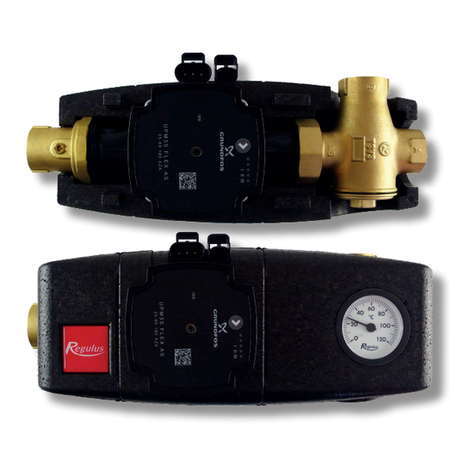
Regulus
Regulus RGMAT E G60 Installation and operation manual

Barford
Barford SR124 Operator's manual & parts list
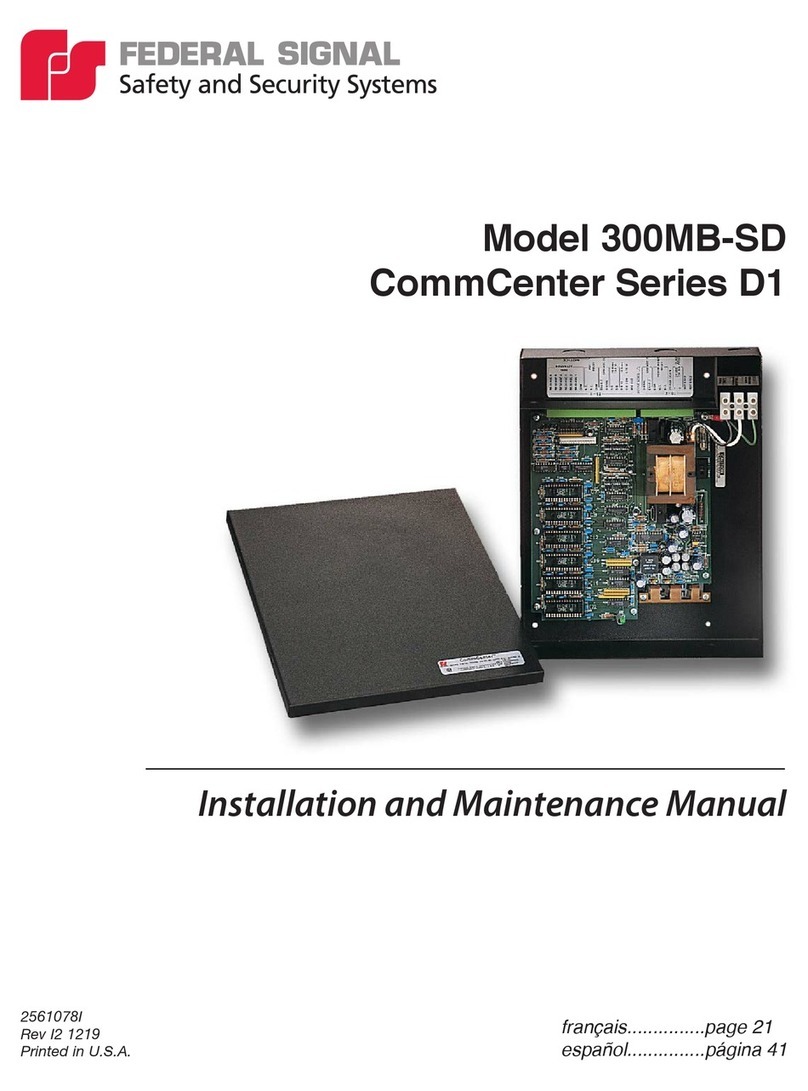
Federal Signal Corporation
Federal Signal Corporation CommCenter D1 Series Installation and maintenance manual
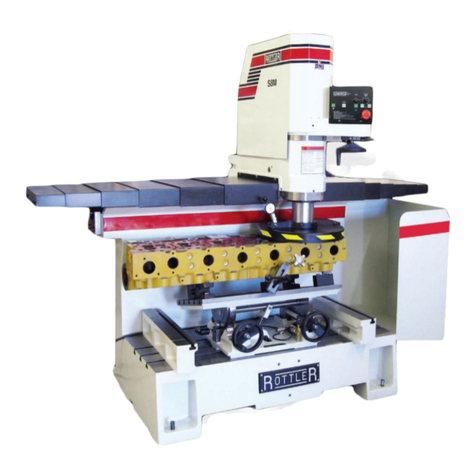
Rottler
Rottler SM Series Operation and maintenance manual
